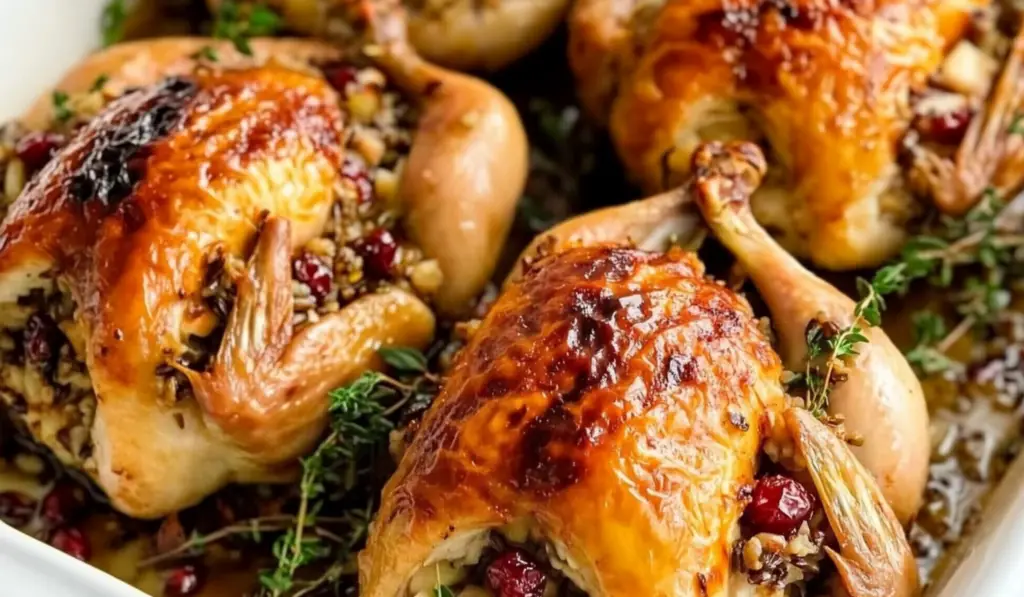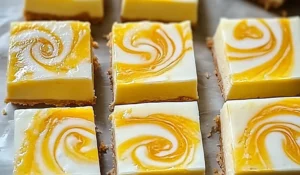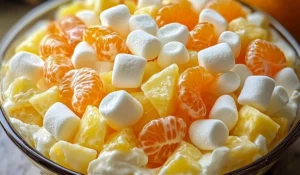When it comes to preparing a meal that’s both impressive and bursting with flavor, stuffed Cornish hens are hard to beat. These tender little birds, perfectly roasted to golden-brown perfection, are filled with a delightful stuffing made from wild rice, fresh herbs, and a sweet yet savory glaze that elevates each bite. The combination of textures—crisp skin, juicy meat, and the hearty, flavorful stuffing—makes for a memorable dish that works wonderfully for holiday feasts, family gatherings, or any special occasion. With a bit of preparation and a careful approach, these stuffed Cornish hens will wow your guests and leave everyone eagerly asking for seconds.

Stuffed Cornish Hens: A Show-Stopping Feast for Every Occasion
When it comes to preparing a meal that’s both impressive and bursting with flavor, stuffed Cornish hens are hard to beat. These tender little birds, perfectly roasted to golden-brown perfection, are filled with a delightful stuffing made from wild rice, fresh herbs, and a sweet yet savory glaze that elevates each bite. The combination of textures—crisp skin, juicy meat, and the hearty, flavorful stuffing—makes for a memorable dish that works wonderfully for holiday feasts, family gatherings, or any special occasion. With a bit of preparation and a careful approach, these stuffed Cornish hens will wow your guests and leave everyone eagerly asking for seconds.
- Prep Time: 30 minutes
- Cook Time: 1 hour 10 minutes
- Total Time: 1 hour 40 minutes
- Yield: 4 servings 1x
- Category: Main Course
- Method: Roasting
- Cuisine: American
- Diet: Gluten Free
Ingredients
For the Wild Rice Stuffing:
- 2 cups wild rice
- 3 cups chicken broth
- 3 tablespoons butter, divided
- 1 cup chopped celery
- 1 cup chopped onion
- 4 cloves garlic, minced
- 2 gala apples, cored and chopped
- ¾ cup pecans, roughly chopped
- ½ cup dried cranberries
- 2 teaspoons fresh chopped rosemary
- 2 teaspoons fresh chopped thyme
- Salt and pepper to taste
For the Glaze:
- ¼ cup honey
- ¼ cup apple cider
- 2 teaspoons fresh chopped rosemary
- 2 teaspoons fresh chopped thyme
For the Cornish Hens:
- 4 Cornish hens (1.5 lbs each)
- Salt and pepper to taste
Instructions
1. Preparing the Wild Rice Stuffing:
The first step in preparing these stuffed Cornish hens is making the wild rice stuffing. Wild rice has a unique, nutty flavor and chewy texture that complements the delicate flavor of the Cornish hens perfectly. To start, cook the wild rice in chicken broth instead of water for an added depth of flavor. The chicken broth will infuse the rice with savory richness, setting the foundation for the stuffing’s overall flavor profile. Follow the instructions on the rice package, but keep a close eye on the cooking time. It’s important not to overcook the rice, as it will continue to cook when baked inside the Cornish hens. When the rice is tender but still has a slight bite to it, remove it from the heat and let it cool uncovered. This cooling process is essential because it prevents the rice from becoming too soft when baked later.
2. Sautéing Vegetables and Adding Flavor:
While the rice is cooling, it’s time to prepare the sautéed vegetables and herbs that will add flavor and texture to the stuffing. Heat 2 tablespoons of butter in a large skillet over medium heat. Once melted, add the chopped celery and onion, stirring occasionally. Sauté the vegetables until they soften and become fragrant, which should take about 3 minutes. Then, add the minced garlic and continue to sauté for an additional 2 minutes. Garlic adds an aromatic depth to the stuffing, and the combination of onion and celery provides a savory base that complements the richness of the wild rice. Once the vegetables are softened and fragrant, transfer them to a bowl and set aside.
3. Incorporating Sweet and Savory Elements:
In the same skillet, melt the remaining tablespoon of butter and add a splash of apple cider. The cider provides a tangy sweetness that balances the savory flavors of the rice and vegetables. Add the chopped apples, pecans, dried cranberries, and fresh herbs—rosemary and thyme. Sauté everything together for about 2 minutes, just long enough for the apples to soften slightly and the cranberries to plump up, releasing their natural tartness. The apples bring a touch of sweetness, while the cranberries offer a delightful contrast with their tartness. The pecans add a satisfying crunch and a warm, nutty flavor that enhances the overall stuffing. Once everything is sautéed and combined, add the cooked rice and the sautéed vegetables back into the skillet. Stir well, ensuring that all the ingredients are evenly distributed. Season with salt and pepper to taste. The stuffing should have a well-balanced flavor with a hint of sweetness from the apples and cranberries, complemented by the earthiness of the rosemary and thyme. Set the stuffing aside to cool slightly before stuffing the Cornish hens.
4. Preparing the Glaze:
Now that the stuffing is ready, it’s time to prepare the glaze. The honey glaze is what ties everything together, adding a glossy sheen and a sweet-savory finish to the Cornish hens. In a small bowl, combine the honey, apple cider, rosemary, and thyme. The honey brings a rich sweetness, while the cider adds a subtle tanginess that enhances the natural flavor of the hens. The fresh herbs infuse the glaze with aromatic qualities that will complement the stuffing inside the hens. Stir until all ingredients are thoroughly mixed and set aside for later use.
5. Stuffing the Cornish Hens:
Preheat your oven to 425°F (220°C), and lightly grease the rack of a roasting pan with butter or cooking spray to prevent sticking. While the oven is heating, pat the Cornish hens dry with paper towels. This step is important to achieve crispy skin, so take the time to dry the hens thoroughly. Place them breast-side up on the prepared roasting rack. Using a spoon, carefully stuff each Cornish hen with about ½ cup of the wild rice stuffing. Be sure not to overstuff, as the rice will expand as it cooks. Tuck the wings under the hens to help them hold their shape and then tie the legs together with baking twine. This will help the hens maintain a compact, uniform shape as they roast, ensuring that they cook evenly.
6. Roasting the Hens:
Once the hens are stuffed and prepared, it’s time to roast them to golden-brown perfection. Brush the honey glaze generously over each hen, ensuring that every inch of the skin is coated. The glaze will caramelize during roasting, creating a beautifully golden crust. Sprinkle the hens with salt and pepper to enhance the flavor of the skin. Place the hens in the preheated oven and roast for 20 minutes at 425°F (220°C). This high heat will help crisp up the skin and give the hens a beautiful golden color.
After 20 minutes, reduce the oven temperature to 350°F (180°C) and brush the hens with the remaining honey glaze. Continue roasting for an additional 40–50 minutes, basting occasionally with the glaze. The hens are done when the internal temperature reaches 165°F (74°C) in the thickest part of the thigh, and the juices run clear. If the hens are browning too quickly, tent them with foil to prevent burning.
7. Resting and Serving:
Once the Cornish hens are cooked through, remove them from the oven and let them rest for about 15 minutes before carving. Resting allows the juices to redistribute, making the meat tender and juicy. Serve the hens with the extra wild rice stuffing, and consider pairing them with a light green salad or roasted vegetables. The richness of the stuffing and the honey glaze pairs beautifully with crisp, fresh side dishes.
Notes
- If you’re not a fan of wild rice, you can use brown rice or quinoa instead. While the texture may differ slightly, these options will still provide a hearty base for the stuffing.
- For a nut-free version, substitute the pecans with sunflower seeds, sliced almonds, or even a handful of toasted breadcrumbs for a different crunch.
- If you’re looking to make the dish more indulgent, you can add sausage to the stuffing mixture for an extra layer of flavor.
Why Choose Cornish Hens?
Cornish hens, or Cornish game hens, are a type of small chicken known for their rich, flavorful meat and elegant presentation. They have tender, juicy meat and a much higher ratio of meat to bone than traditional chickens, making them an ideal choice for stuffing. Their smaller size allows for individual servings, so everyone can enjoy their own portion, which makes them perfect for dinner parties and family celebrations. The beauty of stuffed Cornish hens lies not only in their flavor but in their versatility. The stuffing can be customized based on what’s in season or what you have on hand, and the glaze adds a touch of sweetness that balances the savory richness of the bird. The process of stuffing and roasting Cornish hens may seem intimidating at first, but it’s surprisingly straightforward—and the results are undeniably delicious.
Ingredients:
For the Wild Rice Stuffing:
- 2 cups wild rice
- 3 cups chicken broth
- 3 tablespoons butter, divided
- 1 cup chopped celery
- 1 cup chopped onion
- 4 cloves garlic, minced
- 2 gala apples, cored and chopped
- ¾ cup pecans, roughly chopped
- ½ cup dried cranberries
- 2 teaspoons fresh chopped rosemary
- 2 teaspoons fresh chopped thyme
- Salt and pepper to taste
For the Glaze:
- ¼ cup honey
- ¼ cup apple cider
- 2 teaspoons fresh chopped rosemary
- 2 teaspoons fresh chopped thyme
For the Cornish Hens:
- 4 Cornish hens (1.5 lbs each)
- Salt and pepper to taste
Step-by-Step Guide to Making Stuffed Cornish Hens
1. Preparing the Wild Rice Stuffing:
The first step in preparing these stuffed Cornish hens is making the wild rice stuffing. Wild rice has a unique, nutty flavor and chewy texture that complements the delicate flavor of the Cornish hens perfectly. To start, cook the wild rice in chicken broth instead of water for an added depth of flavor. The chicken broth will infuse the rice with savory richness, setting the foundation for the stuffing’s overall flavor profile. Follow the instructions on the rice package, but keep a close eye on the cooking time. It’s important not to overcook the rice, as it will continue to cook when baked inside the Cornish hens. When the rice is tender but still has a slight bite to it, remove it from the heat and let it cool uncovered. This cooling process is essential because it prevents the rice from becoming too soft when baked later.
2. Sautéing Vegetables and Adding Flavor:
While the rice is cooling, it’s time to prepare the sautéed vegetables and herbs that will add flavor and texture to the stuffing. Heat 2 tablespoons of butter in a large skillet over medium heat. Once melted, add the chopped celery and onion, stirring occasionally. Sauté the vegetables until they soften and become fragrant, which should take about 3 minutes. Then, add the minced garlic and continue to sauté for an additional 2 minutes. Garlic adds an aromatic depth to the stuffing, and the combination of onion and celery provides a savory base that complements the richness of the wild rice. Once the vegetables are softened and fragrant, transfer them to a bowl and set aside.
3. Incorporating Sweet and Savory Elements:
In the same skillet, melt the remaining tablespoon of butter and add a splash of apple cider. The cider provides a tangy sweetness that balances the savory flavors of the rice and vegetables. Add the chopped apples, pecans, dried cranberries, and fresh herbs—rosemary and thyme. Sauté everything together for about 2 minutes, just long enough for the apples to soften slightly and the cranberries to plump up, releasing their natural tartness. The apples bring a touch of sweetness, while the cranberries offer a delightful contrast with their tartness. The pecans add a satisfying crunch and a warm, nutty flavor that enhances the overall stuffing. Once everything is sautéed and combined, add the cooked rice and the sautéed vegetables back into the skillet. Stir well, ensuring that all the ingredients are evenly distributed. Season with salt and pepper to taste. The stuffing should have a well-balanced flavor with a hint of sweetness from the apples and cranberries, complemented by the earthiness of the rosemary and thyme. Set the stuffing aside to cool slightly before stuffing the Cornish hens.
4. Preparing the Glaze:
Now that the stuffing is ready, it’s time to prepare the glaze. The honey glaze is what ties everything together, adding a glossy sheen and a sweet-savory finish to the Cornish hens. In a small bowl, combine the honey, apple cider, rosemary, and thyme. The honey brings a rich sweetness, while the cider adds a subtle tanginess that enhances the natural flavor of the hens. The fresh herbs infuse the glaze with aromatic qualities that will complement the stuffing inside the hens. Stir until all ingredients are thoroughly mixed and set aside for later use.
5. Stuffing the Cornish Hens:
Preheat your oven to 425°F (220°C), and lightly grease the rack of a roasting pan with butter or cooking spray to prevent sticking. While the oven is heating, pat the Cornish hens dry with paper towels. This step is important to achieve crispy skin, so take the time to dry the hens thoroughly. Place them breast-side up on the prepared roasting rack. Using a spoon, carefully stuff each Cornish hen with about ½ cup of the wild rice stuffing. Be sure not to overstuff, as the rice will expand as it cooks. Tuck the wings under the hens to help them hold their shape and then tie the legs together with baking twine. This will help the hens maintain a compact, uniform shape as they roast, ensuring that they cook evenly.
6. Roasting the Hens:
Once the hens are stuffed and prepared, it’s time to roast them to golden-brown perfection. Brush the honey glaze generously over each hen, ensuring that every inch of the skin is coated. The glaze will caramelize during roasting, creating a beautifully golden crust. Sprinkle the hens with salt and pepper to enhance the flavor of the skin. Place the hens in the preheated oven and roast for 20 minutes at 425°F (220°C). This high heat will help crisp up the skin and give the hens a beautiful golden color.
After 20 minutes, reduce the oven temperature to 350°F (180°C) and brush the hens with the remaining honey glaze. Continue roasting for an additional 40–50 minutes, basting occasionally with the glaze. The hens are done when the internal temperature reaches 165°F (74°C) in the thickest part of the thigh, and the juices run clear. If the hens are browning too quickly, tent them with foil to prevent burning.
7. Resting and Serving:
Once the Cornish hens are cooked through, remove them from the oven and let them rest for about 15 minutes before carving. Resting allows the juices to redistribute, making the meat tender and juicy. Serve the hens with the extra wild rice stuffing, and consider pairing them with a light green salad or roasted vegetables. The richness of the stuffing and the honey glaze pairs beautifully with crisp, fresh side dishes.
Serving Suggestions and Variations:
Stuffed Cornish hens are a complete meal on their own, but you can pair them with a variety of sides to make the meal even more special. Roasted Brussels sprouts, sautéed spinach, or mashed potatoes are all excellent choices. For something a little more indulgent, try serving the hens with a creamy potato gratin or a baked macaroni and cheese. The flavors of the stuffing will complement just about any vegetable side, but a bright salad will provide a refreshing contrast to the richness of the meat and stuffing.
Tips for Ingredient Substitutions:
- If you’re not a fan of wild rice, you can use brown rice or quinoa instead. While the texture may differ slightly, these options will still provide a hearty base for the stuffing.
- For a nut-free version, substitute the pecans with sunflower seeds, sliced almonds, or even a handful of toasted breadcrumbs for a different crunch.
- If you’re looking to make the dish more indulgent, you can add sausage to the stuffing mixture for an extra layer of flavor.

Storage and Reheating:
Leftover stuffed Cornish hens can be stored in an airtight container in the refrigerator for up to 3 days. Reheat them in the oven at 350°F (180°C) for about 10–15 minutes, or until heated through. If you have leftover rice stuffing, store it separately in the refrigerator for up to 2 days. To reheat, simply warm it in a skillet over medium heat with a splash of chicken broth or apple cider to bring it back to life.
Conclusion:
Stuffed Cornish hens are a standout dish that combines elegance, flavor, and versatility. Whether you’re preparing this for a special occasion or a simple family dinner, the balance of savory, sweet, and aromatic flavors will leave everyone impressed. The process of making this dish may seem involved, but each step adds an essential element to the final result. From the flavorful wild rice stuffing to the golden glaze and tender meat, these stuffed Cornish hens are sure to become a staple in your recipe repertoire. Enjoy the process of cooking, and relish the rewards when it’s time to carve and serve. Happy cooking!




